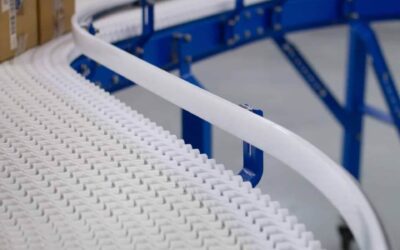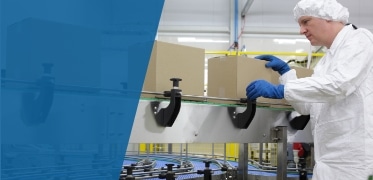An Introduction to Good Manufacturing Practices in the Food Industry

In the world of manufacturing food, following hygiene and quality protocol is vital to having market success and maintaining consumer safety. Any breach of food safety sanitation requirements can cause serious problems. Companies may face:
- Massive cost penalties
- Criminal prosecution
- Production plant closure
- Damage to their brand’s image
- Business Closure
That’s where Good Manufacturing Practices (GMP) come into play. The use of GMP in the food industry is the best way for a manufacturing plant to prevent these protocol violations from happening and maintain a successful business.
What is Food Safety?
According to the U.S. Food and Drug Administration, the food safety movement is a shift in focus from responding to foodborne illnesses to instead preventing them — to be proactive rather than reactive.
The Food Safety Modernization Act was inspired by changes in the global food system and foodborne illness research. It focuses on battling public health problems and threats to the economic well-being of the food system. Food safety is seen as an efficient way to decrease the risk of contamination and abide by the highest food standards available.
What’s the best way to conduct food safety in manufacturing? Our experts have put together a list of good manufacturing practices in the food industry, along with how to apply them in your facility.
1. Pick the Right Location for Your Warehouse
Location, location, location. It’s not just a mantra for real estate. The location of your manufacturing facility can have a major impact on overall food production safety. We explore the importance of finding just the right spot for manufacturing food in this section.
When food is manufactured, it’s no secret that how it’s made is a crucial part of the process. But where it’s made can be just as important. Certain areas and setups are more qualified for manufacturing food than others. If you don’t choose a place carefully, the food can become contaminated. You can avoid this if you know what to look for during the site selection process for your warehouse. Make sure the building you use is durable, easy to clean and safe for your staff.
You also want to keep an eye out for areas known as pest “hot spots,” which are prone to pollution and troublesome critters like insects and rodents. At nearly any stage of the food manufacturing process, cockroaches and flies can cause contamination and food-borne illnesses. If rats and mice find their way into your warehouse, they can damage fixtures and machinery, and they may ultimately spread diseases.
You can prevent this from happening by researching the area and investing in a pest control monitoring system for your warehouse. Abiding by these food safety standards can make a big difference in your company’s success.
2. Maintain a Clean Work Environment
Practicing proper hygiene is a major food safety sanitation requirement. Discover how cleaning and disinfecting your warehouse can impact your manufacturing process.
It may seem like common sense, but cleanliness is crucial when it comes to food production safety. This means preparation areas, machines and devices must be properly cleaned and disinfected before using them again. Sanitizing the devices used for manufacturing food helps eliminate harmful microorganisms that can cause food poisoning.
But the cleanliness shouldn’t stop there. It’s important to provide your employees with suitable containers and waste storage areas. Make sure these areas are far from any food or machinery. You can take the food production safety one step further by having procedures your staff must follow for storage and waste removal. Following these food safety standards will help you reduce the risk of ingredients, equipment and food products becoming contaminated.
3. Execute a Smart Production Flow
What’s the best way to get a manufacturing job done? The smart way. Find out how a more efficient system can enhance food production safety in this section.
We realize the process of manufacturing food isn’t just about the food – it’s also about your team. This method of GMP in the food industry is a “win” for both the company and the workers, too. It involves decreasing safety hazards that might occur on the job and providing a more secure workplace for your employees. One way to go about this food production safety practice is to examine the manufacturing process. Are there instances that are slowing your team down? Better yet, is anything occurring that could be unsafe as they work? Make note of anything that stands out and how it could be improved. Look for opportunities that decrease lag time and minimize your team’s contact with the product itself.
By implementing this GMP in food safety, your team will have an easier, safer work environment and your product will be manufactured better and quicker. Win-win!
4. Use State-of-the-Art-Machinery
Your product is only as good as your machinery. That’s why it’s important to never cut corners when it comes to manufacturing food. We take a look at how the right machinery can impact your production process in this section.
The machinery you use for manufacturing food can make or break everything. If it’s poorly designed or outdated, your company can face endless setbacks. Excess food particles that are hard to clean, contamination in the manufacturing process, lack of sanitation — the list goes on.
To combat this and illustrate what to look for in machinery for manufacturing food, The American Meat Institute’s Equipment Design Task Force developed the following 10 principles:
- Machinery must be cleanable to a microbiological level.
- Compatible materials should make up the machinery’s design.
- Machinery must be accessible for inspection, maintenance, cleaning and sanitation.
- There should never be leftover product or liquid collection.
- Hollow areas must be hermetically sealed.
- No niches.
- The operation performance of the machinery must be sanitary.
- Maintenance enclosures must be of hygienic design.
- Machinery must have hygienic compatibility with other plant systems.
- The overall manufacturing process should follow cleaning and sanitizing protocols.
When your warehouse abides by these food production safety standards, you set the precedent for happy customers, valued co-workers and a thriving business.
Apply GMP in the Food Industry with Help From Span Tech
With advanced machinery, premium control systems and these manufacturing safety tips, your business can flourish and continue to grow in the competitive food industry. With years of experience and passion for food safety in manufacturing, the Span Tech experts are here to help.
The food production industry can be challenging, but it’s no match for the Span Tech experts. With years of experience and a passion for food production safety, we’re here to help. Our specialty conveyors are designed to minimize product damage and maximize sanitation throughout the manufacturing food process. We’re proud to offer you top-of-the-line food handling systems that can be designed to meet the following food industry needs:
- BISSC
- USDA
- FDA
- CE
Reach out today!
Learn more about good manufacturing practices in the food industry and see how Span Tech can help your business adopt them. We’ll do our best to help you improve your processes!














